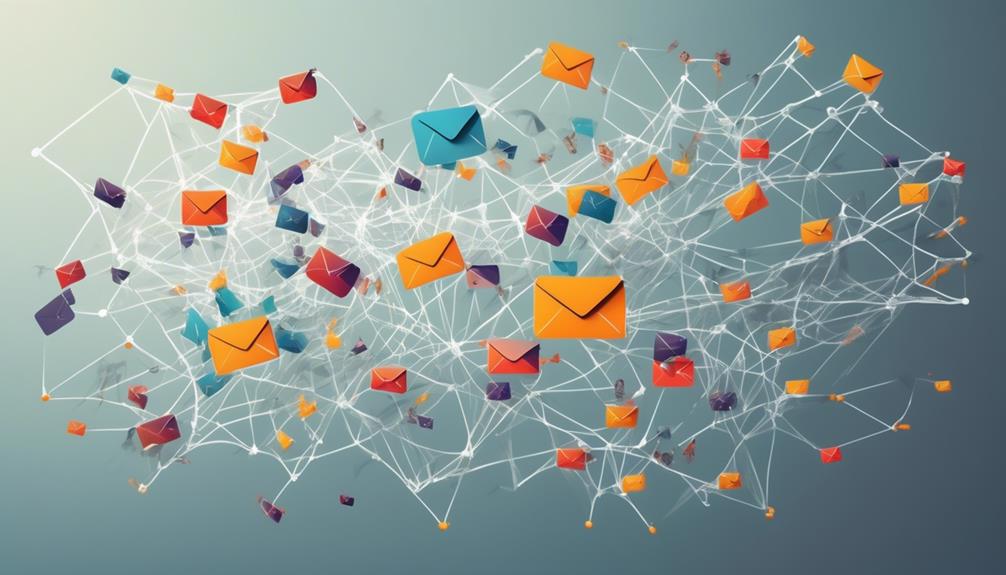Lowering the bounce rates of emails is essential for the success of any email marketing strategy. We’re all familiar with the aggravation of creating the ideal email, just for it to be returned to us. However, there’s no need to worry, as there are established methods to directly address this problem.
By implementing these strategies, we can significantly improve email deliverability and engagement. But what are these strategies, and how can they be effectively applied?
Let's explore five key tactics that can help us reduce email bounce rates and ensure our messages reach their intended recipients.
Key Takeaways
- Implementing double opt-ins is a recommended practice to reduce email bounce rates.
- Regularly cleaning and removing inactive addresses from your email list is essential for high deliverability.
- Avoiding spam triggers such as spam-triggering phrases and terms is crucial to minimize bounces.
- Segmenting your email list and sending targeted, personalized content can help reduce the risk of being marked as spam and improve engagement.
Double Opt-Ins
Implementing double opt-ins is a recommended practice for email list management, ensuring the validity of subscriber email addresses and reducing the likelihood of email bounce rates.
When a new subscriber signs up, they receive an initial confirmation email. This email contains a link or button that the subscriber must click to confirm their subscription. This extra step helps maintain a clean email list by reducing the number of invalid or inactive addresses, ultimately leading to a lower email bounce rate.
By reducing bounce rates, both soft bounces (temporary deliverability issues) and hard bounces (permanent deliverability issues) are minimized. As a result, the overall email deliverability of campaigns improves, ensuring that emails reach the intended recipients.
The double opt-in method follows best practices recommended by reputable email service providers and is an essential step in email list management. Automation tools also streamline the contact list management through the double opt-in process, making it an efficient and effective way to maintain a high-quality email list.
List Cleaning

Regularly cleaning your email list is essential for maintaining high deliverability and reducing bounce rates. By removing inactive and invalid addresses, you can keep your bounce rates low and ensure that your emails reach your intended recipients. Implementing double opt-in verification for new subscribers also helps ensure that you are gathering valid email addresses from the start. Consistent list cleaning is crucial as people often change their email addresses, leading to bounce issues if not updated.
| List Cleaning Strategies | Description | Benefits |
|---|---|---|
| Remove inactive addresses | Regularly remove subscribers who have not engaged with your emails for an extended period. | Reduces bounce rates and maintains a healthy email list. |
| Implement double opt-in | Require new subscribers to confirm their email address, ensuring valid contacts. | Decreases the likelihood of invalid addresses and high bounce rates. |
| Segment and engage | Segment your list based on engagement levels and tailor content to keep subscribers active. | Reduces the chance of being marked as spam and maintains a responsive list. |
| Consistent engagement | Regularly send relevant and engaging content to maintain active contacts. | Helps in keeping bounce rates low and maintaining a healthy list. |
| Use owned sender domains | Utilize your own sender domains and avoid spammy content to improve deliverability. | Reduces the risk of emails bouncing and being marked as spam. |
Cleaning your email list is a critical component of email marketing, ensuring that your messages reach their intended recipients and contribute to a successful campaign.
Avoiding Spam Triggers
To minimize the risk of triggering spam filters and ensure optimal email deliverability, it's crucial to avoid using spam-triggering phrases and terms in your email content.
Spam accounts for a significant portion of email bounces, including both hard bounces (permanent delivery failures) and soft bounces (temporary delivery issues).
Employing email authentication methods such as SPF, DKIM, and DMARC can help prevent your emails from being mistaken for spam.
Additionally, maintaining a clean and updated contact list is essential to avoid sending emails to invalid addresses, which can result in bounce backs and negatively impact your sender reputation. List management practices, such as regularly removing inactive or invalid email addresses, can significantly reduce the likelihood of triggering spam filters.
Furthermore, optimizing email subject lines and content to steer clear of spam-triggering phrases and suspicious copy is instrumental in improving deliverability and reducing the probability of your emails being flagged as spam.
List Segmentation

Utilizing list segmentation enhances the relevance and personalization of email content, ultimately improving engagement and campaign performance. By segmenting your subscriber list based on behavior and characteristics, you can send targeted and personalized emails to specific segments, reducing the risk of being marked as spam and improving overall engagement. This strategy also allows you to re-engage inactive subscribers through customized winback emails, effectively reducing your email bounce rates.
Effective email marketing programs rely on list segmentation to keep email content relevant and engaging for recipients. Email service providers track your email sending reputation and the engagement of your recipients, such as open rates and click-through rates. Segmenting your list effectively can also help maintain a positive sending reputation and deliverability by ensuring that relevant content is delivered to each segment.
Additionally, segmenting your list can help you maintain a good IP address reputation, which is crucial for the success of your email marketing strategy.
Regular Engagement
Engaging subscribers regularly helps maintain open rates and reduce bounce rates. Consistently sending emails to your subscribers can increase engagement and reduce the need for frequent list cleaning. By maintaining regular communication with your audience, you can reduce bounce rates and increase open rates.
Regular engagement with your subscriber list keeps the list active and engaged, resulting in a low bounce rate. It's essential to monitor your bounce and engagement rates to ensure that your emails are reaching subscribers' inboxes. This regular engagement also provides an opportunity to update contact information and remove inactive or invalid email addresses, further contributing to a low bounce rate.
Frequently Asked Questions
How Do I Stop Emails From Being Bounced?
We stop emails from being bounced by implementing several strategies.
First, we regularly clean our email list to remove inactive and invalid addresses.
Second, we use double opt-ins to verify and confirm email addresses.
Third, we avoid spammy content and phrases that could trigger spam filters.
Fourth, we segment our email list based on engagement levels.
Lastly, we consistently engage with our subscribers through regular and meaningful email campaigns.
How Can You Reduce Bounce Rate?
To reduce bounce rates, we regularly clean and update our email list. We implement double opt-in for subscriptions, segment our lists based on engagement levels, and send consistent campaigns to maintain engagement.
Additionally, we avoid using spam-triggering phrases and optimize email subject lines. We also segment our list to avoid spam filters. These strategies have helped us effectively target our efforts and improve our email reputation.
How Do I Fix a High Email Bounce Rate?
To fix a high email bounce rate, we need to implement the following strategies:
- Implement double opt-ins to verify email addresses.
- Regularly clean our email list by removing inactive users.
- Avoid spammy content.
- Segment the email list based on engagement levels.
Consistently engaging with subscribers through regular, meaningful campaigns is crucial to reducing bounce rates. By following these strategies, we can improve email deliverability and decrease the chance of being marked as spam.
What Causes a High Bounce Rate in Emails?
High bounce rates in emails can result from inactive or deleted email accounts. Soft bounces are temporary, while hard bounces are permanent. These impact sender reputation and deliverability.
Implementing double opt-ins and regular list cleaning can help. Using spam-free content, segmenting lists, and engaging subscribers regularly also lowers bounce rates.
This improves overall email deliverability and sender reputation.
Can Strategies for Bypassing Email Spam Filters Also Help Reduce Bounce Rates?
Implementing effective bypass email spam filters strategies can also help reduce bounce rates. By ensuring that your emails are reaching the intended recipients’ inboxes, you can improve deliverability and decrease the likelihood of emails bouncing back. This can ultimately enhance your email marketing efforts and increase engagement with your audience.
Conclusion
In conclusion, by implementing these strategies, we can trim the fat from our email campaigns, ensuring they remain lean and effective.
Like a well-oiled machine, our emails will be streamlined and optimized for success, resulting in higher engagement and lower bounce rates.
Let's continue to monitor and adjust our strategies, using data-driven decisions to propel our campaigns forward.









